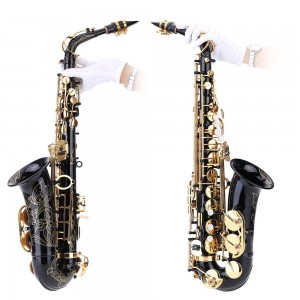I took a bit of a gamble the other week, and bought a cheap (probably Chinese) saxophone on Amazon for about £200.
From what I’ve read recently, the quality of instruments coming out of China has been improving all the time. (See, for example, my previous article on Chinese saxophones and Stephen Howard’s article)
I’ve had my eye on a coloured Alto for a while, and finally decided to go for it when I saw this black-and-gold model on Amazon for a shade under £200. At the price, even if it only lasts 5 years, I figured it would be a better investment than a games console!
Unboxing the sax, I was surprised how heavy it was – clearly they haven’t skimped in metal on the body of the horn. I wasn’t able to tell if this was a particularly heavy horn, as I don’t have another alto to compare it to.
There were some slight sharp edges here and there – probably edges from machining that haven’t been eased off with a file (a task that would no doubt increase the price). Nothing to scratch you, but perhaps a bit uncomfortable.
The paintwork was a bit tacky (sticky) when I first unboxed the sax. This may have been caused by not leaving it long enough to dry before packaging for sale (maybe another cost reduction). I think this could be solved by letting it ‘cure’ in front of a radiator for a week or so, or it might have been because it was left in a cold place during transit.
After I assembled the sax, I was able to play it. Being used to a tenor, I found the fingering was a little close, but assume this is normal for an alto. But when I tested its tuning against a tuner, I found it was in D rather than E♭. This is, apparently, a known problem on new saxophones where the cork is a bit thick and can be addressed with a bit of sandpaper (see this great video by Nigel McGill)
A bit of cork grease allowed me to put the mouthpiece a bit further on, but it was still about a 1/4 tone too flat. Warning! Don’t push the mouthpiece on too hard, or you’ll crack it, and then you’ll have to buy a new mouthpiece sooner than you’d planned!
A few days later, I was practicing A-major scales, and discovered that the C♯ was about a 1/4 tone flat relative to where it should be, and not a semitone apart from C or D. This, I thought, was a much more significant issue, and can’t be easily fixed.
I was able to return the sax, as I’d bought it from Amazon (I would probably have had more difficulty if I’d used a different online provider) and I hadn’t yet attacked the neck cork with sand paper.
I should point out that my experience here may not be typical of other Chinese saxophones. It could be that this was a specific “bought online” issue rather than a problem with Chinese saxophones in general. After all, as a friend pointed out, iPhones are made in China, so the machining must be reasonable! I notice that sax.co.uk sell a Sakkusi for around the £300 mark; if they’re putting that on their website, it must be OK!
In conclusion, I would advise that you play a saxophone before you buy it (which means visiting a music shop, trying some out.)
Update: A few weeks later, went down to sax.co.uk and bought an Alto for around £750, which I’m very happy with. I recollect it feeling lighter to pick up, there were no sharp edges, the paintwork was properly dry, it was in tune with itself [1], but I still needed to sand a smidgen off the cork to get it in tune with the tuner.
[1]: Jay Metcalf has a great video about Playing In Tune.

